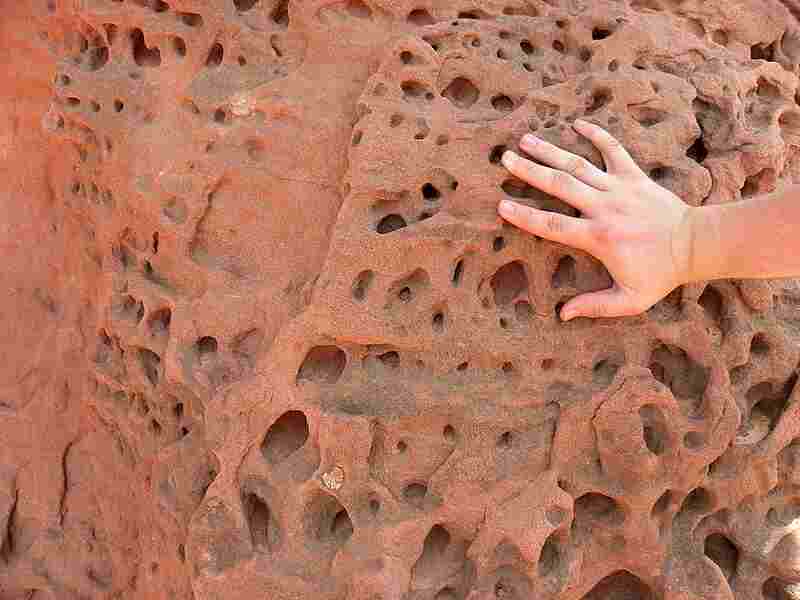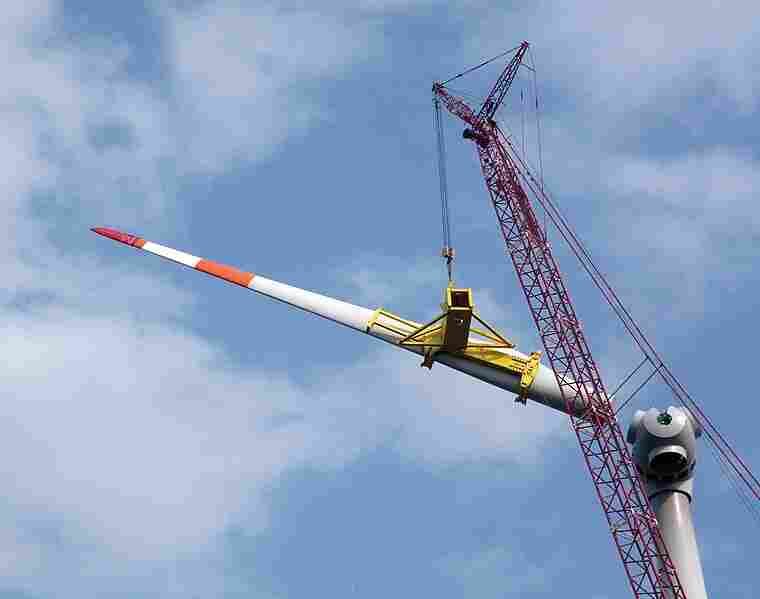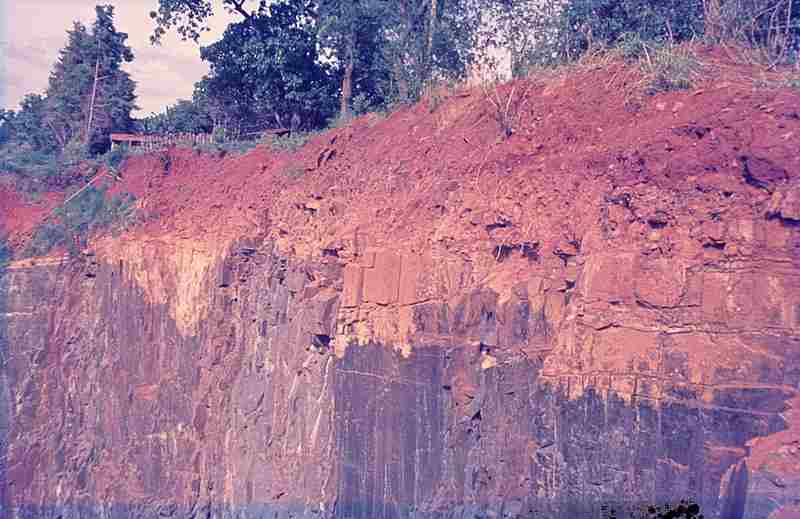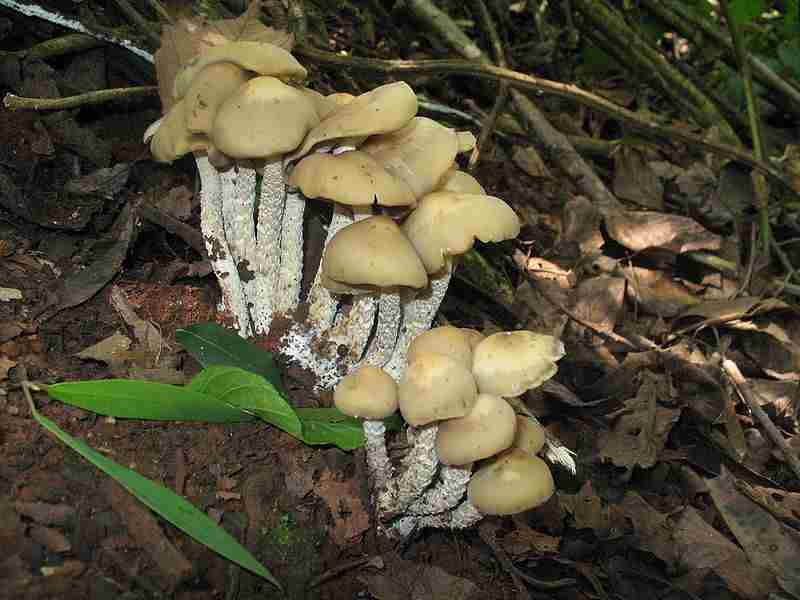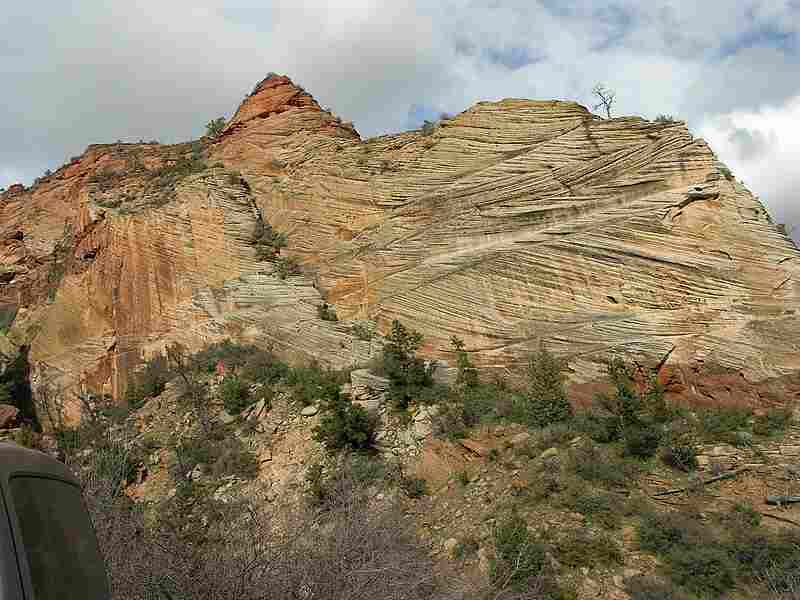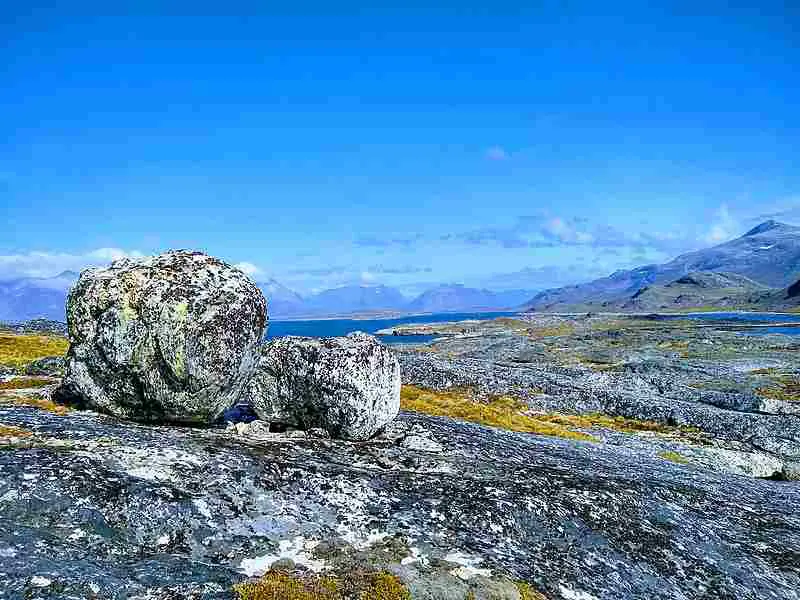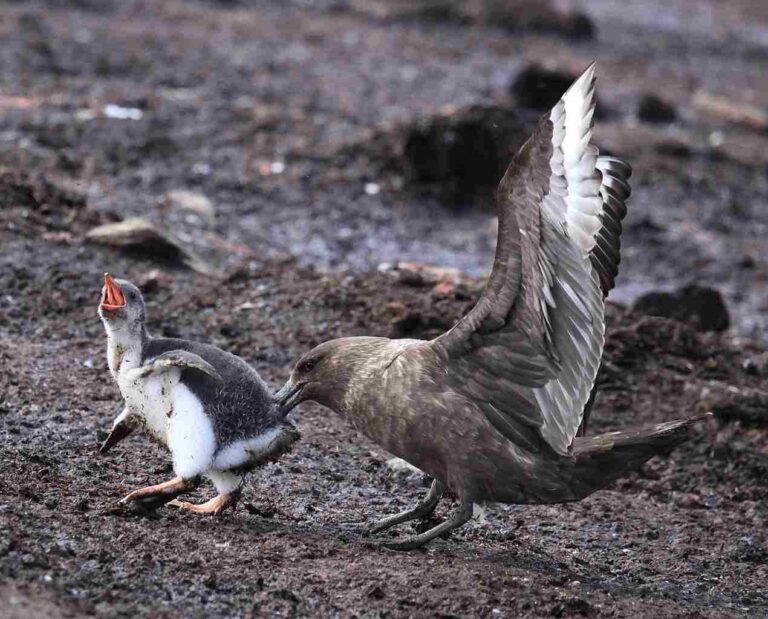11 Agents of Weathering and Their Characteristics Discussed
Agents of weathering are; water, wind, ice, oxygen, acids, salts, physicochemical change, plants, animals, carbon dioxide, and gravity.
This article discusses the agents of weathering and their characteristics, as follows;
1). Water (as one of the Agents of Weathering)
Water plays is an effective agent in both mechanical and chemical weathering processes, where it contributes to the breakdown and alteration of rocks over time.
*Water In Mechanical Weathering
With regards to mechanical weathering, water is most effective in its solid form (ice), which can be considered a separate agent of weathering itself.
In regions where temperatures fluctuate close to freezing levels, water can cause mechanical weathering through a process referred to as frost action or freeze-thaw weathering.
When water seeps into cracks and crevices in rocks, it can freeze in these containment ad temperatures drop. As the water freezes, it expands by about 9%, and exerts pressure on the surrounding rock [7]. This expansion can cause cracks to widen and weaken the rock structure, eventually leading to its fragmentation.
*Water In Chemical Weathering
Water is also a powerful agent of chemical weathering, owing to its ability to dissolve minerals and facilitate chemical reactions.
A common form of chemical weathering involving water is hydrolysis. In this process, water reacts with certain minerals in rocks, causing them to break down and leading to the formation of new compounds. For example; feldspar, a common mineral in many rocks, reacts with water to form clay minerals [16].
Importance of Water as an Agent of Weathering
The importance of water as an agent of weathering is linked to its roles in reaction-facilitation, be mineral formation, landform evolution, and soil formation.
Because water is able to penetrate rock crevices, dissolve minerals, and promote chemical reactions, it can accelerate the overall weathering process. Water facilitates the disintegration of rocks into smaller fragments, which can then be transported (through erosion) and deposited as sediment.
Through chemical reactions with minerals, water contributes to the formation of new minerals, such as clays, oxides, and soluble salts. These new minerals often have different physical and chemical properties than the original rock, so that their formation may alter the overall composition of the landscape.
Water-driven weathering processes are behind the formation of various landforms, including valleys, caves and gorges [1]. Mechanical weathering that is driven by water, can create distinctive features in rocks, such as karst potholes and rock arches.

Soil formation is an immensely important role of water in weathering. Hydrological processes contribute to the breakdown of rocks into smaller particles, which, with further weathering over time, becomes part of the local soil composition.
Soil produced by hydrological weathering is essential for supporting plant growth and ecosystem development.
Lastly, water-driven weathering is responsible for sculpting or shaping both terrestrial and aquatic landscapes over geological time scales. Many geological features like coastal cliffs, isolated sea mounts, and grand canyons, have been shaped by the continuous interaction of water with rock.
Why Water is the Most Important Agent of Weathering
Water is arguably the most important agent of weathering because of its dual role in both mechanical and chemical processes, its versatility of physical state; and its involvement as a facilitator of many phases of the weathering process.
The ability of water (in solid form) to physically fragment rocks through freeze-thaw cycles, and (in liquid form) chemically alter minerals through hydrolysis makes it a flexible and potent weathering force.
Water ubiquitous presence, combined with its capacity to dissolve minerals and promote chemical reactions, gives it prominence among other agents of weathering. The same attributes also make water an important agent of erosion, which usually follows the process of weathering.
Types of Weathering Involving Water
The types of weathering that involve water are; mechanical weathering (specifically frost action or freeze-thaw disintegration) and chemical weathering (hydrolysis). The interaction of water with rocks in various forms is central to the processes that shape the surface of the Earth over time.
2). Wind
Wind is a potent agent of physical weathering, that can sculpt and modify the Earth's surface through a process referred to as abrasion [18].
It is primarily effective in areas with loose or unconsolidated materials such as sand, and dust particles, that can be transported by air currents.
Wind-driven weathering mechanisms can be described using terms like abrasion, sandblasting, and rock polishing.
In abrasion, wind-blown sedimentary particles, such as sand, are made to collide with exposed rock surfaces and other particles, by the prevailing air currents. This collision utilizes the particles as mechanical tools, leading to the gradual wearing down of rock surfaces, with the final outcome being measurable, physical erosion.
Sandblasting is a very similar concept, as it involves wind-driven sand particles that act as natural sandblasters, removing surface layers of rocks through the forceful contact and abrasive action of impacting sand grains.
Over time, the constant abrasion and sandblasting by wind-driven particles can polish rock surfaces, giving them a smoother appearance; and producing notably sculpted features like ventifacts that occur in desert regions [9].

Importance of Wind as an Agent of Weathering
As an agent of erosion, wind is important for its contributions to sedimentation processes, landform development/modification, soil formation, desertification, and the creation of typical desert features like dunes.
Erosion and sediment transport, which occur after weathering, can also be attributed to wind in many areas.
The results of wind erosion include the detachment and mobilization of sedimentary particles from one location to another. Wind-driven sediments can be carried over long distances before they settle, so that weathering may be simultaneous with the transportation and redistribution of materials.
Abrasion by wind can create distinctive landforms, such as mushroom rocks and rock arches, through the selective eroding of softer rock layers and resistance of harder layers.
When wind-borne sediments accumulate in certain areas, thy contribute to the formation of new soil layers [11]. These sediments can sometimes combine with other materials to create fertile soil that supports plant growth.
Desertification is a form of ecological degradation of land, and in some cases accompanies wind-driven weathering. When soil and vegetation are broken down and displaced by wind, the exposed land becomes susceptible to further erosion and degradation.
Lastly, wind can transport loose sedimentary particles, such as fine sand, to form sand dunes in deserts and some coastal areas. These dunes are products of the simultaneous processes of weathering and erosion by aeolian forces, and they play a role in developing the landscape and influencing local ecosystems.
Wind as an Agent of Weathering and/or Erosion
Wind can be considered both an agent of weathering and an agent of erosion, depending on the specific conditions or scenario involved.
As an agent of weathering, wind facilitates the physical breakdown of rock surfaces through abrasion and other mechanical processes.
On the other hand, as an agent of erosion, wind transports sedimentary particles like sand, and dust from one location to another, thereby reshaping landscapes and contributing to the displacement of earth-materials.
3). Ice (as one of the Agents of Weathering)
Ice plays a significant role in the process of weathering, in regions with cold climates.
The most common mechanism of ice-driven erosion involves the expansion and contraction of water as it freezes and melts, which exerts significant mechanical stress on rocks and contributes to their disintegration.
Primary processes related to ice-induced weathering are; frost weathering/cryofracturing, ice wedging, and thermal stress.
Frost weathering or cryofracturing is initiated as water enters cracks and crevices in rocks, in cold climatic regions.
When temperatures drop, the water freezes and expands, thereby exerting pressure on the surrounding rock material. The expansion of ice within cracks and crevices can lead to the progressive fracturing and disintegration of the rock.
Ice wedging is basically identical to the mechanism described above. It is a type of physical weathering in which the repeated freezing and thawing of water within rock cracks, cause the cracks to enlarge [12]. As water freezes and expands, it pushes the surrounding rock apart, gradually breaking down the rock over time.
Thermal stress can be exerted on rocks as a result of rapid temperature changes. Such stress can cause rocks to expand or contract quickly.
This expansion and contraction, can lead to the gradual development of cracks and fractures in the rock. Over time, these areas of weakness can widen and contribute to the mechanical disintegration of the rock.
Importance of Ice as an Agent of Weathering
The importance of ice as an agent of weathering is based on its involvement in rock breakdown, landscape evolution, soil formation, and erosion.
Ice-induced weathering leads to the physical breakdown of rocks into smaller clastic fragments. This process is an essential step in the formation of soil and the recycling of minerals within ecosystems.
In cold climatic zones, ice-induced weathering plays a crucial role in shaping the landscape. Cliffs, valleys, and mountain slopes can be created and modified by repeated freeze-thaw cycles.
As earlier stated, the fragments of rocks produced during ice-induced weathering become part of the parent material for soil formation. This means that ice-induced weathering can be a key aspect of soil evolution. Over time, the weathered rock material may also mix with organic matter and other minerals, such that its dynamics determine the composition and fertility of soil.
Lastly, ice also drives erosional processes that occur after weathering. As ice-induced weathering disintegrates rocks, the resulting fragments can be transported by glacier itself, or other agents such as wind, water, and gravity.
*An Overview of The Definition of Ice in Weathering
In weathering, "ice" refers to frozen water, which mostly occurs in the form of ice crystals within rock cracks and crevices.
Ice is a powerful agent of mechanical weathering, as it contributes to the breakdown of rocks through mechanisms such as frost weathering and ice wedging.
In these mechanisms, the expansion of ice as it freezes exerts pressure on enclosing rock surfaces, leading to the formation of cracks and fractures; and the eventual disintegration of the rock.
Ice plays a major role in shaping landscapes, influencing soil formation, and contributing to the cycling of minerals in ecosystems, particularly in cold climates.
4). Oxygen
Oxygen is a highly reactive element that is effective in chemical weathering processes which alter the composition of rocks and their component minerals.
The mechanism of oxygen-induced weathering primarily involves oxidation; a chemical reaction in which oxygen combines with other elements or compounds, leading to the alteration of minerals like pyrite [4]. This implies that the key process related to oxygen-induced weathering is oxidation reaction.
One of the most common examples of oxidation in weathering is the reaction of iron with oxygen to form iron oxide.
This process can occur in iron-mineralized rocks, as well as in metallic materials, where it is called corrosion or rusting.
Iron-bearing minerals in rocks can react with oxygen, which leads to the formation of iron oxide compounds.
This reaction results in a change in the minerals' composition, color, and texture. For example, the red color in some sedimentary rocks and soils is attributed to the presence of iron oxide [20]. Changes accompanying mineral oxidation often lead to disintegration.

Importance of Oxygen as an Agent of Weathering
Oxygen is important as an agent of weathering due to its involvement in oxidation reaction, soil formation, as well as color and structural change.
Chemical weathering processes often rely on oxygen as a primary driver, of the oxidative alteration of minerals in rocks.
These processes are important for the breakdown of rocks and the release of essential elements that contribute to soil formation.
Products of oxidation, such as iron oxide, eventually constitute part of soil composition. These weathered minerals are viable parent materials for soil development.
Oxygen is significant for its ability to drive both physical and chemical alteration of earth materials. Through oxidation reactions, changes occur in the color of rocks and the chemical makeup of minerals. Color changes are themselves indicative of the chemical changes occurring due to oxidative weathering.
Structural and textural changes also accompany the reaction between oxygen and minerals. These changes make the minerals more susceptible to further weathering and erosion.
*Definition of Oxygen in Weathering
In weathering, "oxygen" refers to the element (O2) that is present in gaseous form, in the atmosphere.
Oxygen is a highly reactive gas that is involved in various chemical reactions, including those that drive weathering processes. Weathering that is induced by oxygen primarily involves oxidation, where the oxygen reacts with minerals in rocks to form new compounds, leading to the disintegration of the rock.
Examples of Oxidation in Weathering
Examples of oxidation in weathering are the formation of hematite and magnetite respectively; which are iron oxide minerals that result from the assimilation of oxygen by iron-bearing rocks.
The oxygen may be derived directly from the atmosphere, or may be dissolved in water (such a rainwater or flowing stormwater) that comes in contact with the rock.
These oxidized minerals generally have low resistance to weathering and erosion, so that their formation accelerates the breakdown of parent rocks.
As earlier stated, iron rusting is another common example of oxidative disintegration. While it does not represent classic weathering, rusting effectively illustrates the deteriorative-potential of oxygen as a reactive agent of weathering.
5). Acid(s) (as one of the Agents of Weathering)
Acids play a huge role in chemical weathering processes, because they alter the molecular composition/structure of rocks and minerals.
These acids react with minerals in rocks, leading to their dissolution, transformation, and eventual breakdown.
One of the primary sources and components of acid in weathering is carbon dioxide (CO2), which combines with water (H2O) to form carbonic acid (H2CO3) [21].
The mechanism of acid-induced weathering involves processes like carbonation and acid rain formation.
Carbonation involves the dissolution of carbon dioxide from the atmosphere or soil, in rainwater, to form carbonic acid. This weak acid then reacts with minerals in rocks, leading to their dissolution and alteration.
Acid rain may be produced from other types of acid gases, such as sulfur dioxide (SO2) and nitrogen gases (NOx). These gases are released from both natural and anthropogenic sources like power plants, volcanoes, and coastal areas. Acid rain can further enhance chemical weathering.
Importance of Acid as an Agent of Weathering
The importance of acid as an agent of weathering stems from its roles in mineral dissolution, soil formation, and carbon cycling.
Acids, especially carbonic acid, are capable of dissolving minerals in rocks. This effect alters the composition of the rocks and contributes to the formation of new minerals.
Dissolution induced by acids, weakens the structure of rocks, and makes them more susceptible to physical weathering processes. The breakdown of weakened rocks into smaller particles facilitates the formation of soil.
Minerals dissolved by acids may contribute to the accessible stream of essential elements, which become part of the soil composition. The weathered products may serve as the parent material of soils.
Lastly, the interaction of carbon dioxide with water to form carbonic acid is an essential aspect of the global carbon cycle [3]. It plays an important role in geological carbon sequestration, which is the process whereby carbon is captured and stored in geological formations.
Overview of the Acid Agent of Weathering
The acid agent of weathering refers to weak acids, such as carbonic acid (H2CO3), and sulfuric acid (H2SO4), which are formed by the interaction of atmospheric gases with water.
These weak acids are behind the chemical alteration and disintegration of minerals in rocks, which lead to weathering.
*Example of Acid in Weathering
An example of acid-induced weathering is the reaction between carbonic acid and minerals in rocks.
Carbon dioxide (CO2) from the atmosphere dissolves in rainwater (H2O), to form carbonic acid (H2CO3). This weak acid reacts with minerals in rocks, causing their dissolution and alteration.
For example, limestone, which is primarily composed of calcium carbonate (CaCO3), can be dissolved by carbonic acid, resulting in the formation of products like calcium bicarbonate (Ca(HCO3)2) [10].

6). Salts
Salts, especially in arid and coastal terrains, can contribute significantly to rock weathering through a process known as salt weathering or haloclasty [13].
This process involves the disintegration of rocks due to infiltration of cracks and joints by saline solutions, that subsequently evaporate and leave behind salt crystals.
The mechanism of salt weathering includes; infiltration, evaporation, salt crystal growth, expansion and fragmentation.
In infiltration, saltwater, which contains dissolved salts, flows/seeps into cracks and pores within rocks.
As the water containing the dissolved salts subsequently evaporates due to arid conditions or strong heating, the salts are left behind as crystals.
The salt crystals left behind, begin to grow (due to progressive precipitation and physicochemical influence) within the rock's pores, exerting pressure on the surrounding rock material. This usually leads to mechanical stresses and the gradual breakdown of the rock.
Expansion and fragmentation is a combined process whereby expanding salt crystals within confined spaces like pores and fractures, creates stress that weakens the structure of the affected rock. Over time, the pressure from such crystal growth may lead varying degrees of fragmentation.
Importance of Salt as an Agent of Weathering
Salt is important in weathering for its contributions to rock disintegration, landform evolution, soil formation, and deterioration of manmade structures.
Rock disintegration is an outcome of salt weathering, involving the breakdown of rock massed into smaller fragments, and contributing to the formation of erodible sediment.
In arid environments, salt weathering can contribute to the evolution of unique landforms, such as salt pans, honeycomb weathering patterns, and desert pavements.
Weathered rock fragments that result from salt weathering, can contribute to the component-material of soils in many regions.
Salt weathering can cause substantial deterioration of building stones, masonry materials, and monuments made from natural rock or carbonate materials [14].
How Salt Serves as an Agent of Weathering: A Recap
Salt serves as an agent of weathering through the process of salt weathering or haloclasty.
In this process, saline solutions infiltrate pores and cracks within rocks (with which they may also chemically react), and when these solutions evaporate, salt crystals are left behind.
The growth of these salt crystals exerts pressure on the surrounding rock, leading to its gradual mechanical breakdown.
An example of salt weathering is the honeycomb deterioration pattern seen in rocks along coasts or arid terrains [17]. In this case, saltwater infiltrates rock cracks, and as the water evaporates, salt crystals precipitate progressively, such that they continue to increase in volume.
The expansion of these crystals over time exerts pressure on the rock, causing it to break apart and producing a honeycomb-like pattern.

Salt weathering is also known as salt wedging, salt crystallization, or haloclasty.
7). Physicochemical Change (as one of the Agents of Weathering)
As the name implies, physicochemical weathering involves the combined action of physical and chemical processes that lead to the breakdown and alteration of rock materials.
It often occurs as a result of the interaction of environmental factors such as temperature, pressure, water, and chemical reactions.
Mechanism of Physicochemical Weathering
The mechanism of physicochemical weathering is base on temporal variation or change, in the physicochemical conditions to which earth materials are subjected.
These changes encompass various other types of weathering (because weathering is highly dependent on physical and chemical forces) and may involve parameters like temperature, pressure, pH, salinity, oxygen concentration, water availability, and air quality conditions.
In effect, what this implies is that physicochemical change is one of the agents of weathering. Some links between weathering and physicochemical change are discussed briefly;
Temperature and pressure variations are behind many cases of rock disintegration. Cycles of temperature changes, especially in areas with diurnal temperature fluctuations, can cause rocks to expand and contract.
This repetitive stress weakens the rock fabric, making it more vulnerable to further weathering. Pressure changes are often associated with uplift and erosion, and can also cause rocks to crack and exfoliate.
Freeze-thaw cycles represent another form of physicochemical change that leads to weathering.
In cold climatic zones, water may enter cracks and pores in rocks while in liquid state. During freezing, the water expands as it transforms into ice (sold state), and the expanding ice exerts pressure on the rock. This expansion can cause cracks to widen and result in the breakage and dislodging of rock fragments.
The deteriorative effects of plant and animal activities on rocks can also be classified under this category, since they involve physical and chemical changes.
Root action stems from the ability of plant roots to grow into existing rock fractures and exert pressure as they increase in mass and volume, thereby forcing the rock to break apart [15]. As roots continue to grow, they further contribute to rock fragmentation.
Animals that burrow into soil and rock masses, can create crevices and fractures, which expose rocks to the effects of other weathering agents such as water and air.
Pressure release and exfoliation can be associated with tectonic forces in the Earth. As rocks are uplifted due to these tectonic forces, the reduction in pressure can lead to the expansion of minerals within the rock. This process, known as exfoliation, can cause layers of rock to peel away from the surface.
Importance of Physicochemical Change as an Agent of Weathering
Physicochemical change is important as an agent of weathering, because it contributes to rock fragmentation, soil formation, and landscape evolution.
Fragmentation occurs when physicochemical changes lead to the breakdown of rocks into smaller components, increasing surface area and making the affected rocks to become more susceptible to intensive weathering.
Soil formation can be attributed to the erosion and accumulation of fragments resulting from physicochemical weathering. Smaller particles provide a suitable substrate for the sequestration of organic biomass and the growth of both plants and microbial/arthropod communities.
Also, the combination of physical and chemical processes, sculpts and modifies the landscape over time. Erosion, sedimentation, and the exposure of formerly buried or overlain rock surfaces, are all influenced by physicochemical weathering.
*The Physical Changes of Weathering
Physical changes of weathering include temperature, pressure, color and structural changes that lead to the mechanical breakdown of rocks into smaller fragments.
These changes can occur through processes like;
1. Freeze-thaw
2. Tectonism
3. Exfoliation
4. Root action
5. Burrowing by living organisms
Five Factors that Affect Physical Weathering
Five factors that affect physical weathering are; rock composition, climatic condition, elevation/depth of burial, organic activity, and chemical reactions.
Physical weathering can be discussed in terms of temperature variations, pressure changes, freeze and thaw cycles, root action, burrowing, among others. These areas are briefly recapped below;
Cycles of temperature changes cause expansion and contraction of rocks.
Uplift and erosion-related pressure changes can lead to cracks and exfoliation.
Repeated freezing and thawing of water within rocks cause expansion and fracture.
Plant roots that grow into rock fractures exert pressure and cause mechanical stress.
Animals burrowing into rocks create openings and fractures, promoting further weathering.
8). Plants
Plants play a significant role in the process of weathering, known as biological weathering. This type of weathering is primarily a mechanical process, driven by the physical actions of plants and their roots.
The mechanism of plant-induced weathering involves root growth, penetration, wedging, and chemical degradation.
Root penetration occurs as plant roots grow into small cracks and crevices in rocks, in search of moisture and nutrients. As these roots grow and expand, they exert pressure on the surrounding rock materials.
With continued growth of plants, their roots can exert considerable force on the rocks, which may cause the cracks in the rocks to widen, and sizeable fragments to break off.

Root wedging is a term used to describe the process whereby roots work their way into existing cracks, and, as they expand, force the cracks to widen, eventually causing the rock to split and fall apart.
In addition to their physical influence, plants can contribute to weathering through chemical processes. Compounds like root exudates and various organic acids, can chemically break down minerals in the rocks, thereby weakening the rock structure.
Importance of Plants as Agents of Weathering
The importance of plants as agents of weathering is based on their involvement in rock fragmentation, soil formation, and landscape evolution.
Fragmentation occurs as plant roots physically break rocks masses apart, leading to the formation of smaller rock fragments, that contribute to the creation of soil over time.
Fertile soil forms when the fragments produced by plant-induced weathering are mixed with organic matter (which could also be supplied by plants). Such soil provides a medium for further plant growth, accumulation of nutrients, and recurrent plant weathering.
The evolution is landscapes in areas where plant weathering is dominant, can also be attributed to this process. Over prolonged periods of time, the action of plant roots can contribute to the erosion and breakdown of rocks, on a large-scale, so that this results in widespread changes across the landscape.
Although they can facilitate degradation, plant roots can also stabilize soil and mitigate erosion by holding the soil particles together.
Type of Weathering Caused by Plant Roots
The type of weathering caused by plant roots is mechanical weathering; but may also be called biological weathering, since it is driven by loving organisms.
Mechanical weathering involves the physical breakdown of rocks into smaller fragments without causing any change to the rocks' chemical composition. Plant roots, by exerting pressure and causing cracks to widen, are instrumental to the mechanical breakdown of rocks.
This process is an example of how living organisms can actively participate in geological processes.
9). Animals (as Agents of Weathering)
Animals, both above and below ground, can contribute effectively to the process of weathering through their activities.
The mechanism of animal-induced weathering involves disaggregation by burrowing/tunneling, digging and trampling, among others [6].
Burrowing animals of various kinds, such as moles, prairie dogs, shrews, and earthworms, all create tunnels in the ground. These tunnels can extend through rocks and facilitate weathering by weakening and disaggregating the rock structures.
Terrestrial animals that dig or trample the ground, including rodents and larger mammals, contribute to the breakdown of rocks on the surface. Their actions can cause rocks to disintegrate and crumble over time.
Lastly, animals facilitate chemical and hydrological weathering processes by creating pathways for air and water to reach deeper layers of rocks. This establishes exposure and contact, with resulting chemical reactions that enhance the severity and rate of weathering.
Importance of Animals as Agents of Weathering
Animals are important as agents of weathering because they contribute to the fragmentation of rocks, formation of soils, sediment aeration, landscape evolution, and recycling of nutrients in ecosystems. Must of these functions are already discussed in preceding sections. Below is a brief recap;
1. Animals that dig or burrow can cause fragmentation of physical breakage of rocks, leading to the formation of smaller rock masses or particles. These materials contribute to the processes of erosion, deposition, and soil formation.
2. The rock fragments brought to the surface by animals undergo further sedimentation and humification to form soil. This process can lead to the development of fertile soils that support more organic growth.
3. Animal burrows and tunnels create pathways for air and water to penetrate deeper layers of rocks. This can accelerate chemical weathering by increasing the rate at which water and oxygen react with minerals.
4. Activities of animals, especially burrowing creatures, can alter the structure and composition of rocks over time, influencing the aesthetics and geomorphology of the landscape.
5. Animal activity can promote nutrient cycling by helping to mix organic matter and nutrients with the soil, which enhances the overall productivity of the ecosystem.
Examples of Weathering Caused by Animals
Examples of weathering caused by animals include;
1. Disaggregation by burrowing
2. Surface disturbance (such as trampling)
3. Rock degradation through detritivorous feeding activity
10). Carbon Dioxide
Carbon dioxide (CO2) produces a weak acid when dissolved in water, namely carbonic acid (H2CO3). For this reason, It plays an effective role in chemical weathering through the process known as carbonation.
From this article, it can be noticed that carbon dioxide, water, and acids are all involved as co-facilitators in some chemical weathering processes. Yet, it is correct to consider and discuss each one of them as a separate, distinct agent of weathering.
The mechanism by which carbon dioxide induces weathering, is simply carbonation.
Carbonation occurs when rainwater containing dissolved carbon dioxide, falls through the atmosphere and comes into contact with rocks.
The reactive combination of carbon dioxide with water molecules produces carbonic acid, which reacts with certain minerals in the rocks, such as calcium carbonate, to create new, soluble compounds.
These soluble compounds have low resistance and can be washed away by water, leading to the breakdown of affected rock masses.
Importance of Carbon Dioxide as an Agent of Weathering
Carbon dioxide is important as an agent of weathering for its involvement in chemical dissolution, soil formation, and carbon cycling.
Along with water, carbon dioxide is one of the primary agents responsible for chemical weathering. It participates in the breakdown of minerals in rocks, causing changes in their chemical composition over time.
Through carbonation, carbon dioxide facilitates the dissolution or alteration of minerals like calcium carbonate, which is a common component of many rocks [8]. This can contribute to the physical disintegration of the affected rocks.
Products of the weathering of minerals by carbonic acid, can become part of the soil composition, and may enrich existing soils with essential nutrients.
Also, the process of chemical reaction of carbon dioxide with rocks and minerals, is part of the global carbon cycle. Carbon dioxide is exchanged between the atmosphere, rocks, soil, and water bodies, influencing both geological and climatic processes.
Carbon Dioxide and Other Agents in Weathering Roles
Carbon dioxide works in association with other agents of weathering, like oxygen, water and acids.
1). Carbon Dioxide and Oxygen
Both carbon dioxide and oxygen are active ingredients in chemical weathering. Oxygen causes oxidation, a type of chemical reaction, when combined with certain reactive minerals. Carbon dioxide, as carbonic acid, reacts with minerals and alters their compositions.
2). Carbon Dioxide and Water
As mentioned several times so far; carbon dioxide dissolves in water to form carbonic acid. This acid can react with minerals, leading to their breakdown.
Therefore, water in combination with carbon dioxide, enhances the process of chemical weathering.
3). Carbon Dioxide and Acids
Carbonic acid is a weak acid produced by the dissolution of carbon dioxide in water.
It increases the acidity of rainwater, which is then able to further enhance weathering (through acidic chemical reactions) when it comes in contact with rocks.
*Overview of Carbon Dioxide in Weathering
Carbon dioxide is an agent of chemical weathering through its role in carbonation.
The type of weathering caused by carbon dioxide is chemical weathering.
Weathering affects carbon dioxide reserves by causing the release of carbon from rocks and minerals as they disintegrate, thereby influencing the global carbon cycle.
The roles of carbon dioxide and oxygen in chemical weathering are carbonation and oxidation respectively. Both processes alter the composition of minerals in rocks.
11). Gravity (as one of the Agents of Weathering)
Gravity is a fundamental force that influences the dynamic of rocks and soil on the Earth's surface.
It is important to acknowledge that although gravity is often listed as an agent of weathering, more appropriate classification will be rather as an agent of erosion.
This is because gravity plays a huge role in various forms of rock and sediment displacement, collectively known as mass wasting or mass movement [2].
Since weathering on the other hand has to to with disintegration and dissolution (rather than displacement), it can be argued that gravity's role in this area is rather secondary.
With these important facts stated, this article discusses the general role of gravity in the dynamics of earth materials (rocks, sediments).
Gravity as a Driver of Rock/Sediment Dynamics
Gravity causes the downward movement of rock masses, as well as soil and debris, on slopes.
As disaggregated materials accumulate on elevated surfaces due to weathering and erosion, they become susceptible to the force of gravity. When the force of gravity exceeds the friction or shear resistance holding these materials in place, they begin to move downhill, often resulting in hazards like landslides [19].
Any of various factors can trigger the action of gravity in mass movement, including heavy rainfall, earthquakes, volcanic activity, and human activities. These factors destabilize the balance between the gravitational force and the frictional resistance, leading to the movement of materials down slopes.
Importance of Gravity in Weathering-Related Processes
Gravity is important for its roles in slope modification, erosion, deposition, and landslide formation, among other processes.
Slope modification relies on gravity as a potent force for shaping the landscape, by moving rock fragments and soil downhill.
Over extended periods of time, this movement contributes to the modification of undulating areas, creating features like talus slopes [5].
Erosion and deposition accompany the movement of materials downslope due to gravity, as rocks and soil are transported and gradually broken down. The deposition of these materials at the base of slopes can produce alluvial fans, debris flows, and other sedimentary features.

Gravity-induced landslides can occur when the stability of a slope is compromised. These hazardous events can have major implications on the landscape, nearby urban infrastructure, and natural ecosystems.
*Overview of Gravity in Weathering
Gravity is not a direct cause of weathering; rather, it is responsible for mass movement or mass wasting processes, which are erosion phenomena where weathered materials are moved downslope.
This implies that gravity is not considered an agent of weathering in the traditional sense. It is an agent of mass movement, displacement or erosion, rather than a process that alters the structure or composition of rocks.
Conclusion
Agents of weathering are;
1. Water
2. Wind
3. Ice
4. Oxygen
5. Acids
6. Salts
7. Physicochemical Changes
8. Plants
9. Animals
10. Carbon Dioxide
11. Gravity
References
1). Antón, L.; Mather, A. E.; Stokes, M.; Muñoz-Mart, A.; De Vicente, G. (2015). "Exceptional river gorge formation from unexceptional floods." Springer Nature, Nature Communications 6(1):7963. Available at: https://doi.org/10.1038/ncomms8963. (Accessed 27 August 2023).
2). Balasubramanian, A. (2011). "MASS-WASTING." Available at: https://doi.org/10.13140/RG.2.2.10405.50407. (Accessed 27 August 2023).
3). Balasubramanian, A. (2017). "The Carbon Cycle." Available at: https://doi.org/10.13140/RG.2.2.15706.64962. (Accessed 27 August 2023).
4). Chigira, M.; Oyama, T. (2000). "Mechanism and effect of chemical weathering of sedimentary rocks." Engineering Geology 55(1-2):267-278. Available at: https://doi.org/10.1016/S0165-1250(00)80022-X. (Accessed 27 August 2023).
5). Dolnicki, P.; Grabiec, M. (2022). "The Thickness of Talus Deposits in the Periglacial Area of SW Spitsbergen (Fugleberget Mountainside) in the Light of Slope Development Theories." Land 11(2):209. Available at: https://doi.org/10.3390/land11020209. (Accessed 27 August 2023).
6). Hall, K.; Boelhouwers, J.; Driscoll, K. (1999). "Animals as Erosion Agents in the Alpine Zone: Some Data and Observations from Canada, Lesotho, and Tibet." Arctic Antarctic and Alpine Research 31(4):436-446. Available at: https://doi.org/10.1080/15230430.1999.12003328. (Accessed 27 August 2023).
7). Huang, S.; Yao, N.; Ye, Y.; Cui, X. (2019). "Strength and Failure Characteristics of Rocklike Material Containing a Large-Opening Crack under Uniaxial Compression: Experimental and Numerical Studies." International Journal of Geomechanics, Volume 19, Issue 8. Available at: https://doi.org/10.1061/(ASCE)GM.1943-5622.0001477. (Accessed 27 August 2023).
8). Kamaljit; S.; Benaiah, A. U.; Martin, B. J.; John, C. (2018). "Partial dissolution of carbonate rock grains during reactive CO2-saturated brine injection under reservoir conditions." Advances in Water Resources, Volume 122, p. 27-36. Available at: https://doi.org/10.1016/j.advwatres.2018.09.005. (Accessed 27 August 2023).
9). Knight, J. (2008). "The environmental significance of ventifacts: A critical review." Earth-Science Reviews 86(1):89-105. Available at: https://doi.org/10.1016/j.earscirev.2007.08.003. (Accessed 27 August 2023).
10). Lackner, K. S. (2002). "Carbonate Chemistry for Sequestering Fossil Carbon." Annual Review of Energy and the Environment 27(1). Available at: https://doi.org/10.1146/annurev.energy.27.122001.083433. (Accessed 27 August 2023).
11). Lyles, L.; Tatarko, J. (1985). "Wind erosion effects on soil texture and organic matter." Journal of Soil and Water Conservation 41(3). Available at: https://www.jswconline.org/content/41/3/191. (Accessed 27 August 2023).
12). Maľa, M.; Greit, V.; Ondrášik, M. (2022). "Pore structure evolution in andesite rocks induced by freeze–thaw cycles examined by non-destructive methods." Springer Nature, Scientific Reports 12(1). Available at: https://doi.org/10.1038/s41598-022-12437-5. (Accessed 27 August 2023).
13). Mottershead, D. N. (1989). "Rates and patterns of bedrock denudation by coastal salt spray weathering: A seven‐year record." Earth Surface Processes and Landforms 14(5):383 - 398. Available at: https://doi.org/10.1002/esp.3290140504. (Accessed 27 August 2023).
14). Oan, A. (2019). "Detorioration of masonry and concrete structures due to salt weathering - state of art." Available at: https://www.researchgate.net/publication/333377310_Detorioration_of_masonry_and_concrete_structures_due_to_salt_weathering_-_state_of_art. (Accessed 27 August 2023).
15). Pawlik, Ł.; Malik, I.; Ślęzak, A.; Wistuba; M. (2018). "A study of the wood anatomy of Picea abies roots and their role in biomechanical weathering of rock cracks." CATENA 173:264-275. Available at: https://doi.org/10.1016/j.catena.2018.10.018. (Accessed 27 August 2023).
16). Rex, R. W.; Mart, B. D. (1966). "Clay Mineral Formation in Sea Water by Submarine Weathering of K-Feldspar." Clays and Clay Minerals 14(1):235-240. Available at: https://doi.org/10.1346/CCMN.1966.0140120. (Accessed 27 August 2023).
17). Rodriguez-Navarro, Doehne, E.; Sebastián, E. (1999). "Origins of honeycomb weathering: The role of salts and wind." Geological Society of America Bulletin 111(8):1250-1255. Available at: https://doi.org/10.1130/0016-7606(1999)111<1250:OOHWTR>2.3.CO;2. (Accessed 27 August 2023).
18). Shrestha, D. P. (2008). "Guidelines for monitoring and assessment of wind erosion at site level." Available at: https://doi.org/10.13140/2.1.4927.9682. (Accessed 27 August 2023).
19). Souisa, M.; Sapulete, S. M.; Tuarissa; J. C. (2020). "Back Calculation of Slope Stability in Batu Gadjah, Ambon City Using the Solution of Analytical and Finite Element Method." Journal of Physics Conference Series 1463(1):012034. Available at: https://doi.org/10.1088/1742-6596/1463/1/012034. (Accessed 27 August 2023).
20). Vodyanitskii, Y. N. (2001). "Iron minerals in soils on red-colored deposits." Eurasian Soil Science 34(7):774-782. Available at: https://www.researchgate.net/publication/280879610_Iron_minerals_in_soils_on_red-colored_deposits. (Accessed 27 August 2023).
21). Zolkos, S.; Tank, S. E.; Kokeli, S. (2018). "Mineral Weathering and the Permafrost Carbon-Climate Feedback." Wiley, Geophysical Research Letters 45(18). Available at: https://doi.org/10.1029/2018GL078748. (Accessed 27 August 2023).
